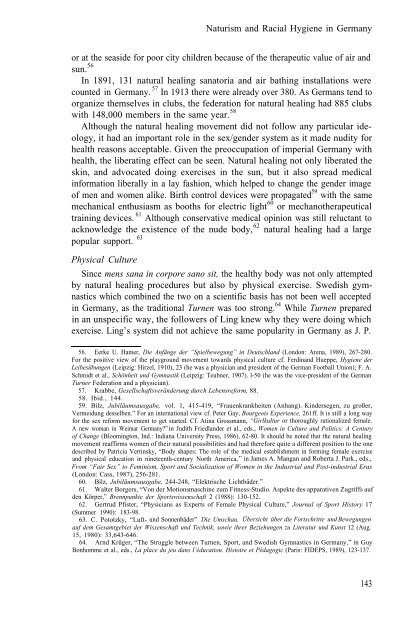There Goes This Art of Manliness: Naturism and ... - LA84 Foundation
There Goes This Art of Manliness: Naturism and ... - LA84 Foundation
There Goes This Art of Manliness: Naturism and ... - LA84 Foundation
Create successful ePaper yourself
Turn your PDF publications into a flip-book with our unique Google optimized e-Paper software.
<strong>Naturism</strong> <strong>and</strong> Racial Hygiene in Germany<br />
or at the seaside for poor city children because <strong>of</strong> the therapeutic value <strong>of</strong> air <strong>and</strong><br />
sun. 56<br />
In 1891, 131 natural healing sanatoria <strong>and</strong> air bathing installations were<br />
counted in Germany. 57 In 1913 there were already over 380. As Germans tend to<br />
organize themselves in clubs, the federation for natural healing had 885 clubs<br />
with 148,000 members in the same year. 58<br />
Although the natural healing movement did not follow any particular ideology,<br />
it had an important role in the sex/gender system as it made nudity for<br />
health reasons acceptable. Given the preoccupation <strong>of</strong> imperial Germany with<br />
health, the liberating effect can be seen. Natural healing not only liberated the<br />
skin, <strong>and</strong> advocated doing exercises in the sun, but it also spread medical<br />
information liberally in a lay fashion, which helped to change the gender image<br />
<strong>of</strong> men <strong>and</strong> women alike. Birth control devices were propagated 59 with the same<br />
mechanical enthusiasm as booths for electric light 60 or mechanotherapeutical<br />
training devices. 61 Although conservative medical opinion was still reluctant to<br />
acknowledge the existence <strong>of</strong> the nude body, 62 natural healing had a large<br />
popular support. 63<br />
Physical Culture<br />
Since mens sana in corpore sano sit, the healthy body was not only attempted<br />
by natural healing procedures but also by physical exercise. Swedish gymnastics<br />
which combined the two on a scientific basis has not been well accepted<br />
in Germany, as the traditional Turnen was too strong. 64 While Turnen prepared<br />
in an unspecific way, the followers <strong>of</strong> Ling knew why they were doing which<br />
exercise. Ling’s system did not achieve the same popularity in Germany as J. P.<br />
56. Eerke U. Hamer, Die Anfänge der “Spielbewegung” in Deutschl<strong>and</strong> (London: Arena, 1989), 267-280.<br />
For the positive view <strong>of</strong> the playground movement towards physical culture cf. Ferdin<strong>and</strong> Hueppe, Hygiene der<br />
Leibesübungen (Leipzig: Hirzel, 1910), 23 (he was a physician <strong>and</strong> president <strong>of</strong> the German Football Union); F. A.<br />
Schmidt et al., Schönheit und Gymnastik (Leipzig: Teubner, 1907). l-50 (he was the vice-president <strong>of</strong> the German<br />
Turner Federation <strong>and</strong> a physician).<br />
57. Krabbe, Gesellschaftsveränderung durch Lebensreform, 88.<br />
58. Ibid., 144.<br />
59. Bilz, Jubiläumsausgabe, vol. 1, 415-419, “Frauenkrankheiten (Anhang). Kindersegen, zu großer,<br />
Vermeidung desselben.” For an international view cf. Peter Gay, Bourgeois Experience, 261ff. It is still a long way<br />
for the sex reform movement to get started. Cf. Atina Grossmann, “Girlkultur or thoroughly rationalized female.<br />
A new woman in Weimar Germany?” in Judith Friedl<strong>and</strong>er et al., eds., Women in Culture <strong>and</strong> Politics: A Century<br />
<strong>of</strong> Change (Bloomington, Ind.: Indiana University Press, 1986), 62-80. It should be noted that the natural healing<br />
movement reaffirms women <strong>of</strong> their natural possibilities <strong>and</strong> had therefore quite a different position to the one<br />
described by Patricia Vertinsky, “Body shapes: The role <strong>of</strong> the medical establishment in forming female exercise<br />
<strong>and</strong> physical education in nineteenth-century North America,” in James A. Mangan <strong>and</strong> Roberta J. Park., eds.,<br />
From “Fair Sex” to Feminism. Sport <strong>and</strong> Socialization <strong>of</strong> Women in the Industrial <strong>and</strong> Post-industrial Eras<br />
(London: Cass, 1987), 256-281.<br />
60. Bilz, Jubiläumsausgabe, 244-248, “Elektrische Lichtbäder.”<br />
61. Walter Borgers, “Von der Motionsmaschine zum Fitness-Studio. Aspekte des apparativen Zugriffs auf<br />
den Körper,” Brennpunkte der Sportswissenschaft 2 (1988): 130-152.<br />
62. Gertrud Pfister, “Physicians as Experts <strong>of</strong> Female Physical Culture,” Journal <strong>of</strong> Sport History 17<br />
(Summer 1990): 183-98.<br />
63. C. Pototzky, “Luft- und Sonnenbäder” Die Umschau. Übersicht über die Fortschritte und Bewegungen<br />
auf dem Gesamtgebiet der Wissenschaft und Technik, sowie ihrer Beziehungen zu Literatur und Kunst 12 (Aug.<br />
15, 1980): 33,643-646.<br />
64. Arnd Krüger, “The Struggle between Turnen, Sport, <strong>and</strong> Swedish Gymnastics in Germany,” in Guy<br />
Bonhomme et al., eds., La place du jeu dans l’éducation. Histoire et Pédagogic (Paris: FIDEPS, 1989), 123-137.<br />
143

















